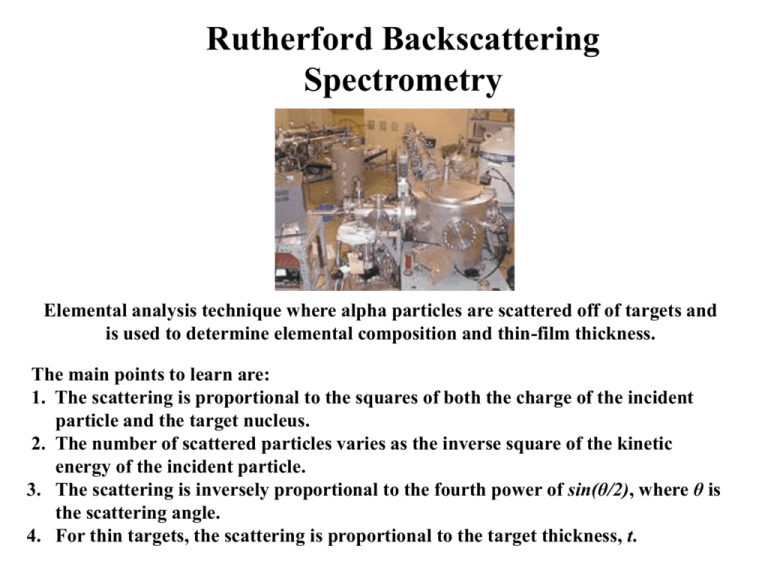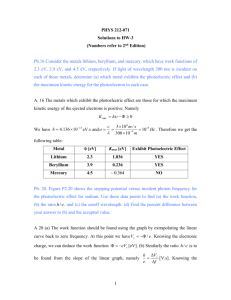RBS
advertisement

Rutherford Backscattering Spectrometry Elemental analysis technique where alpha particles are scattered off of targets and is used to determine elemental composition and thin-film thickness. The main points to learn are: 1. The scattering is proportional to the squares of both the charge of the incident particle and the target nucleus. 2. The number of scattered particles varies as the inverse square of the kinetic energy of the incident particle. 3. The scattering is inversely proportional to the fourth power of sin(θ/2), where θ is the scattering angle. 4. For thin targets, the scattering is proportional to the target thickness, t. The Rutherford Scattering Experiment Scattering line Fradial Ftangential Mprojectile vo b Incident particle approaches at a separation distance, b, called the impact parameter, from the target nucleus and scatters at an angle with respect to its initial direction due to the Coulomb force. Mtarget ze Ze Fscattering 40 r2 1 where z = 2 and Z = atomic number of target Momentum triangle and the Impulse equations zZe 2 pradial 2mv0 sin I radial cos dt 2 2 4 r 0 p pf = mvf ptangential 0 I tangential 0 p0 = mv0 Central force means constant angular momentum: d r2 L mv0b mr dt d dt v0b 2 I radial zZe 2 zZe 2 1 cos dt cos d 2 4 r 4 v b 0 0 0 Limits of integration and the impact parameter: ; i I radial f 2 2 i f i f zZe 2 40 v0b 2 zZe 2 cos d cos p 2 mv sin radial 0 40 v0b 2 2 2 zZe 2 b cot 2 40 mv0 2 Relation between b and ! The Kinematic Factor - K The kinematic factor is the ratio of the scattered alpha particle’s energy to its incident energy gives a convenient method for determining the elemental make up of the target atoms in the sample. To determine K we proceed as follows… He He M M Assuming that the collision is elastic we apply conservation of momentum and kinetic energy to the above situation to obtain: p x : mHevi , He mHev f , He cos MV cos p y : 0 mHev f , He sin MV sin KE : pi2,He 2mHe p 2f , He 2mHe pM2 2M The Kinematic Factor - K We eliminate the dependence and the momentum of the target nucleus (since it is difficult to measure anyway) in favor of the mass of the target atom, the mass of the helium nucleus and the scattering angle . E1 1 K E0 mHe M 2 2 2 mHe cos M mHe sin 2 Knowing, or calculating the kinematic factor allows you to determine the mass of the target atom and thus chemically identify the atom. Now what you need is a target and a spectrum of number of detected alpha particles versus the energy of the alpha particles. To calibrate the energy spectrum (so we know the leading edge energy in order to calculate the kinematic factor) we use a known energy alpha emitter. Our choice is 241Am whose alpha particle energies are approximately 5.4 MeV. The RBS Experiment Start with a beam of 3.3 MeV alpha particles incident on a target of unknown composition. Determine the elemental composition of the sample based on the energies of the scattered alpha particles. Chemical identification based on the kinematics factor. Letting: M1 = mass of helium ion, M2 = mass of target species, = scattering angle. 2 E 1 M 1 cos M 22 M 12 sin 2 scattered K Eincident M 1 M 2 Chemical identification of the target elements using the kinematic factor. E0 = 2.0 MeV He E1 = 1830 keV K = 0.9150 M2 = 181amu Tantalum This is a spectrum of 2.0 MeV alpha particles incident on a thin film of “unknown composition” scattered at 170o. Thickness determination from a thin-film. E a x E KE0 E1 Incident a-particle, Eo Scattered a-particle from front edge, KEo counts Incident a-particle, Eo Scattered a-particle from back edge, E and emerges with E1 Al peak E1 KEo Energy Thickness determination from a thin-film. x dE x E cos 1 E0 x E Inward: 1 -angle between incident beam and horizontal. 1 x dE E cos 2 KE x E Outward: If E x 2 -angle between exiting beam and horizontal. is assumed constant along the inward and outward paths, then dE x E E E0 x E Inward: x E E0 in 1 x dE x Outward: E cos 2 E KE x E E1 KE out Here we don’t know the energy at the back edge, rather only the energy that leaves the target having been scattered from the back edge. So we can eliminate this energy E. Thickness determination from a thin-film. Solving for E and equating the two resulting expressions we find: E E1 E E E0 x x in K x x out K cos 2 From our diagram we see that E KE 0 E1 E K x E x in 1 x Sx out cos180 Which give us a depth scale that is linear in the energy loss of the alpha particle. S is called the energy loss factor, which involves the stopping power of the alpha particle in the element in question and as the alpha particle travels farther it loses energy in proportion to the penetration depth in the sample. In general the stopping powers are not constant, but energy dependant. However, if the film is thin then these stopping powers will be roughly constant. Surface Energy Approximation for S0 in Thin Films. If x is small then E will be small and then we can evaluate the stopping powers on the from and back surfaces. Thus we find: E S0 x 1 E K cos180 x E0 KE 0 So, now we have to look up S0 for a particular element and for a given . After the elements are identified, you can use the tables provided to look up S0 for your element and from E, you can calculate the thickness of the films on the surface of the substrate and the thickness of the substrate. Now for Ta, we find at 2.0 MeV and = 170o, So = 118.1 eV / A. Thus the thickness of the tantalum foil is: E 0.045 106 eV x 381A ev So 118.1 A For this lab you are given 3 files of .spe type •Open the files with a text editor and delete the header and footer BUT take the calibration data first from the footer. •The energy calibration data is in the footer and is the only number given that is not zero. This represents the number of keV per channel, of which there are 8192 of them. •Save the file as a .dat or .txt file. •Import the data in to Excel and make a thin-line curve using the energy calibration that you took. Determine the elemental composition of the each of the three spectra. ONLY from the PHY300_RBS_160degree_ManyElements data that you have, determine the thickness of each of the layers that were seen. Be very careful when looking at the graphs you make. There are some very small peaks that need to be determined. Do not worry about doing an uncertainty analysis for this lab. The lab report for everyone is due next Thursday, June 6 at noon.





